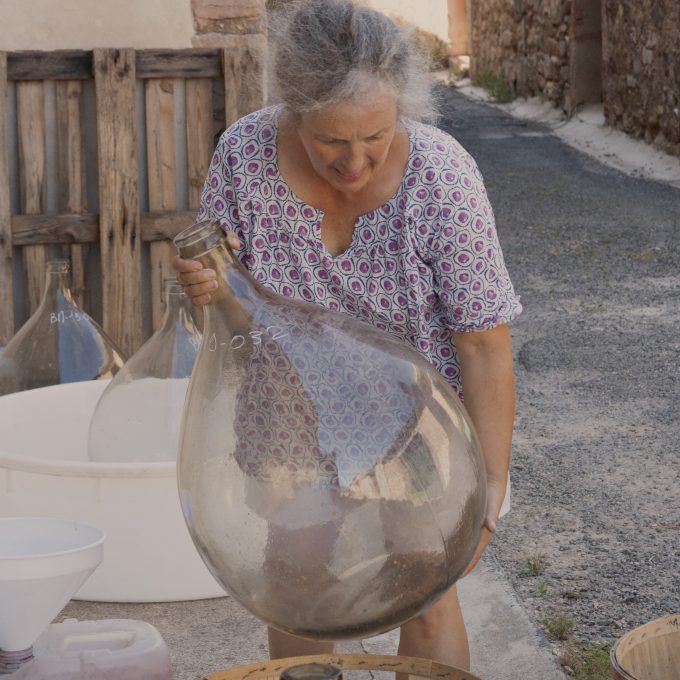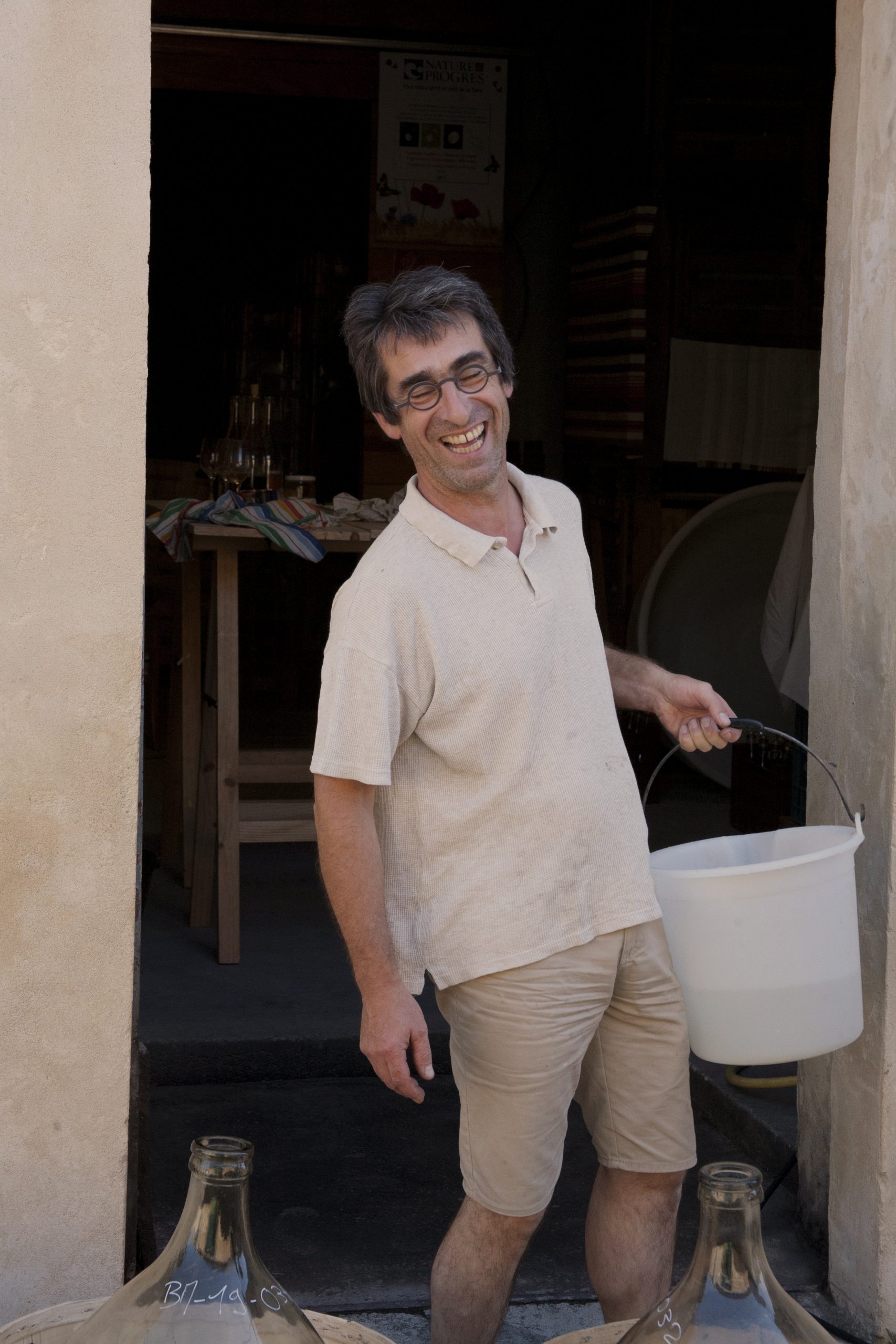
Visiting vineyards and inviting growers to London is nothing short of a pipe dream at the moment, so we thought it would be nice to interview some of the incredible people behind your favourite wines. First we have Nathalie Guillevic and Etienne Granier of Les Petites Mises, who farm four hectares of vines hidden amongst woodlands in Quarante, a tiny village northwest of Beziers in the Hérault.
In just a few short years, Nathalie and Etienne are already producing wines have a rare sense of clarity and focus. We sat down with them to find out just what makes their wines so special.
Their wines are available on Tutto a Casa
Hello Nathalie & Etienne. How are you and how is the situation with the pandemic there?
We are now in February and it is starting to get warmer. Soon the almond trees will blossom and in the afternoon we’ll work in a t-shirt, so it is starting to feel a little more pleasant. With the pandemic, it is less fun. We aren’t as affected as we would be in the city, or if we were doctors, but get-togethers are more rare, even if we occasionally see friends or people visit the cellar.
Please tell us a little about yourselves. Where are you both from originally and how did you discover wine?
We are both from the Languedoc, near Montpellier. Here vineyards, wine, are all part of the environment, but natural wine is something we discovered in Ardèche. Nathalie was working at a shop that sold the wines of Gerald and Jocelyne Oustric, alongside people like Alain Allier, Michel Guignier, Yannick Peltier and so on. All the producers of natural wines from the Ardèche, as well as many other regions.

Did you work alongside other vignerons before starting to make wine yourselves?
We visited a lot of growers. But we have only worked with Marc Salerno at La Bastidonne. Before that we had already been interested by some growers that were working with very simple equipment or very little investments, but with Marc, we discovered outdoor vinification, without a cellar, without electricity, without products other than infusion of peach leaves. This pleased us, and our way of working is an adaptation of the ‘méthode Salerno’.
Were there any other producers that were particularly influential for you when you were starting out?
There were a lot of influences. There are wines that have touched us, which are often very different to the ones we make. Then there are the growers’ characters, even those we’ve met for just a few hours who have provided anecdotes or advice that we still remember today. We must mention Yannick Peltier and Jeff Coutelou who guided us when we were just starting out here. Then there are those whose methods or wines have left a mark on us like Philippe Wies, Daniel Sage, Michel Auger, Bruno Allion, Alain Castex, Olivier Cousin and others.
What was it that made you want to start growing grapes and making your own wine?
It’s like eating and cooking. First we taste, we love, so we eat, we cook, then we cultivate … with wine we have followed the same journey. We ended up planting 200 feet of Gamay in the Ardèche, but then Marc Salerno convinced us that it was strange to spend the week working in an office or shop, when we spent all our free time in the vines.
The farm is in a beautiful part of the Hérault, how did you find it and what was it that made you decide to settle here?
We were living in the Ardèche and looking for a piece of land with little relief, cultivated without chemicals, with plots close to each other and a variety of grapes. There were many requirements, but none of these were geographic. We found an offer for this pretty place in the Hérault. The owner was retiring and selling these five hectares. Before she was bringing the grapes to a cooperative cellar, but she farmed without chemicals and with a AB certification.
Could you please tell us a little more about the farm?
The land is between the border of the Bézier plain and the first pillars of Saint Chinian’s mountain. There are five hectares, a mazet (a small house in the vineyard to find shelter during the day) and a stream of water that only flows during the winter and our chai is eight kilometres away from the Quarante village.
Three hectares are planted with Carignan, Macabeu, Syrah and one hectare is occupied by young vines of Mourvèdre, Clairette, Picpoul and Aramon. In the Macabeu plot we also find a little bit of Terret and Ugni Blanc, and at the edge of the plants of Aramon there are 200 feet of Bourboulenc. The Syrah and the younger vines are facing East, the other vineyards are facing West. The soil is clay-limestone, with some parts by the stream of water more loamy. There aren’t many pebbles, except for the plot of Aramon.
We leave the remainder of the land to rest, to promote biodiversity. We let pines and ash trees grow and add fruit trees whenever we have a chance. In this dry and hot region, plants don’t grow that quickly. In the plot of Mourvèdre, where the topsoil is shallow, we plant garlic, potatoes and broad beans to eat at home.
The farm is on a plain around 150 metres above sea level and the stream provides a humid environment even in summer. There is dew in the morning until June, and on summer mornings there is sometimes mist from the sea, which is only thirty kilometres away.
What is your approach to work in the vineyards?
We believe in nurturing life in the vineyards and bringing freshness. So we don’t use any chemicals, we let the grass grow, without intervention, we let some trees grow as well, for the freshness and for the birds. We are happy about the variety of flowers and grasses on our farm and of course there are earthworms and ants to provide help.
In the vineyard we practice taille douce: we cut exclusively the wood from the year and dead woods not to waste the sugar retained by the plant and limit wounds from cutting. We keep from four to six cordons for each vine. In spring, we do a green harvest to keep the woods selected during the winter. This allows to maintain the leaves more aerated, and simplify the following winter’s cut without leaving any wounds, since the stems removed are still green. The woods that stay, we let them grow as they please, because the extremity of the branches works in cooperation with the extremity of the roots for both growth and the hormone production.
In our little valley there is humidity throughout all spring, so we have to treat mildew and oidium. We treat each ten days with very low doses of sulfur and copper if necessary; we dilute these in nettle infusions, comfrey, burdock, horsetail, yarrow, willow and sometimes with essential oils. We don’t have a tractor and all treatments are made with tools we carry on our backs.
We are fascinated by your use of demijohns for élevage, what inspired this decision?
It is the traditional method in Italy and Provence to mature and preserve the wine, which we learned working with Marc Salerno. As glass doesn’t allow any oxygen in, our wines retain their primary aromas.
Have you experimented with any other vessels?
Due to the small capacity of the bombonnes (54 litres) the work is extremely slow. They take up a lot of space so we’ve started trying with terracotta amphorae covered in rosin, a type of resin obtained from pines, which allows a level of sealing close to that of glass. We tried it out for the first time in 2020 with a 350 litres amphorae and we’ll taste the results at the end of this year.
We find your wines striking in their purity, clarity and focus. What is it that you look for in a wine?
What we like in a red wine is a fine texture, well integrated aromas of spices as well as some bitterness: thyme, blackcurrant, blood orange, ripe pomegranate. Many varieties allow to achieve this result by harvesting ripe fruit and allowing the alcoholic fermentation to eat all the sugars. With white wines we have a more broad taste: fresh or slightly oxidative, aromas of honey, flowers, and a bright acidity. It’s essential for us that the wine is pleasant to drink and easy to digest.
This is a relatively young project, what does the future hold for Les Petites Mises?
In terms of our vineyards, we hope our Carignan plants will have a long life ahead. We planted some Mourvèdre which should complement first eventually replace the Syrah. For the whites, we hope starting to pick some Picpoul, Ugni and Clairette in 2022 to vinify with the Macabeu. This will allow us to pick the Macabeu when it us a little more ripe, preserving its powerful aromas, while at the same time giving more acidity and a little less alcohol.
Finally, as we haven’t had the chance to visit you yet, could you tell us about a particular local product, ingredient or dish we should look forward to trying?
At the farmer’s market in Béziers there are some good local artisans. The regional specialty is the pâté de Pézenas: a little sweet/savoury pastry filled with orange marmalade and mutton fat; to eat very hot and in small portions. In the Étang de Thau there are producers of natural oysters and depending on the season, lagoon fish which have a very unique taste as they eat all of the mussels.
Thank you for your time Nathalie and Etienne, we hope to finally be able to come and visit you soon.